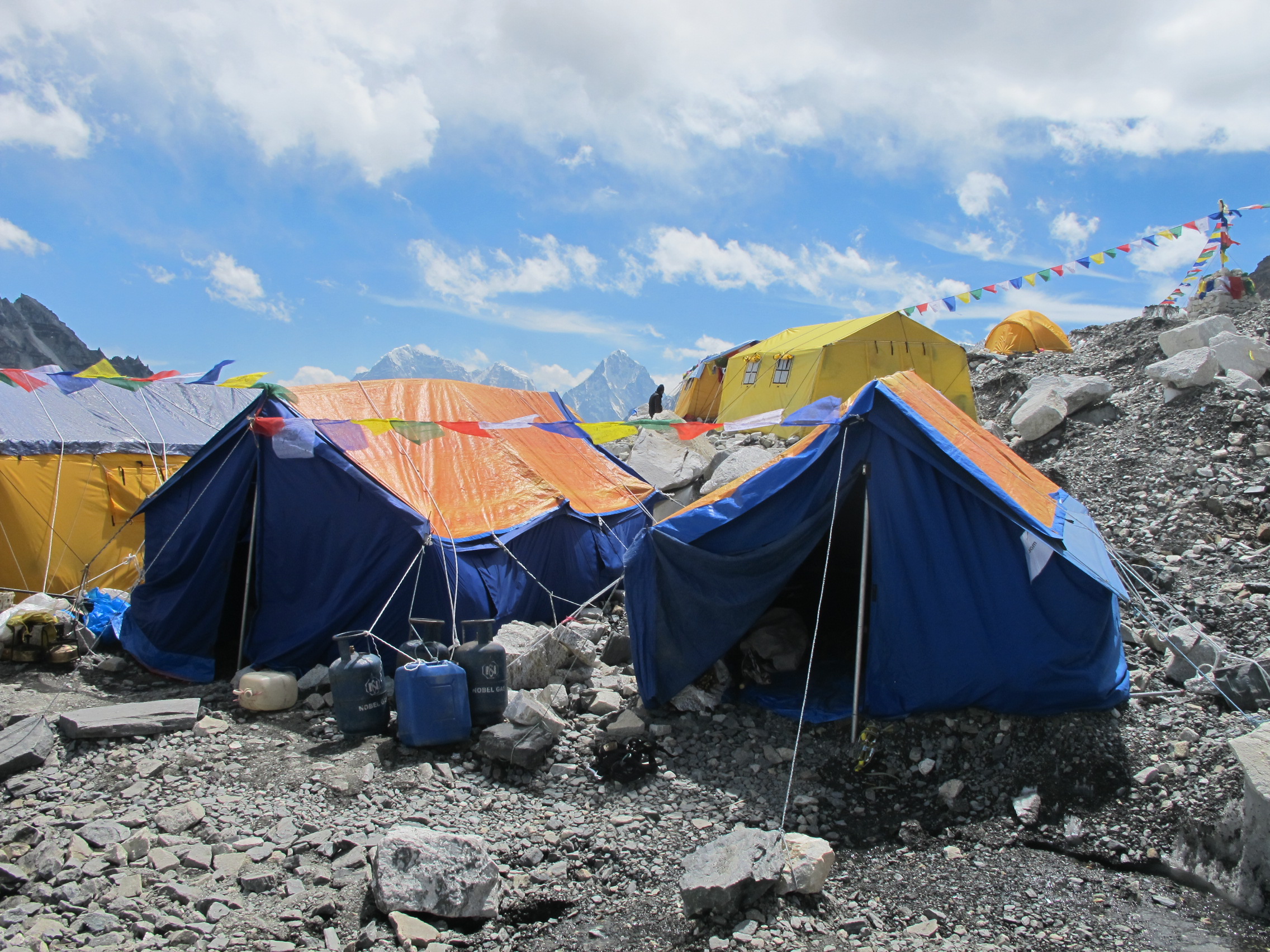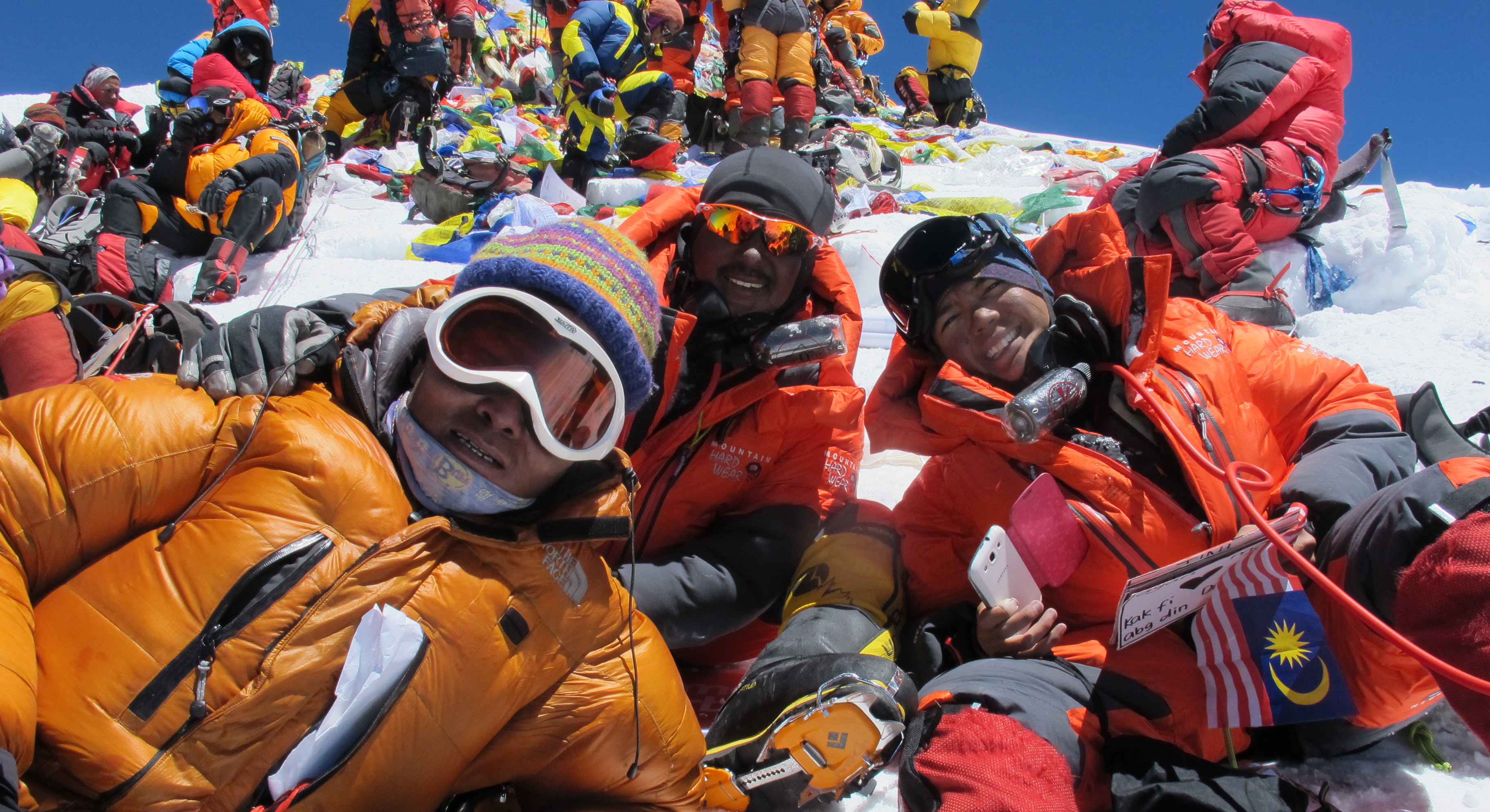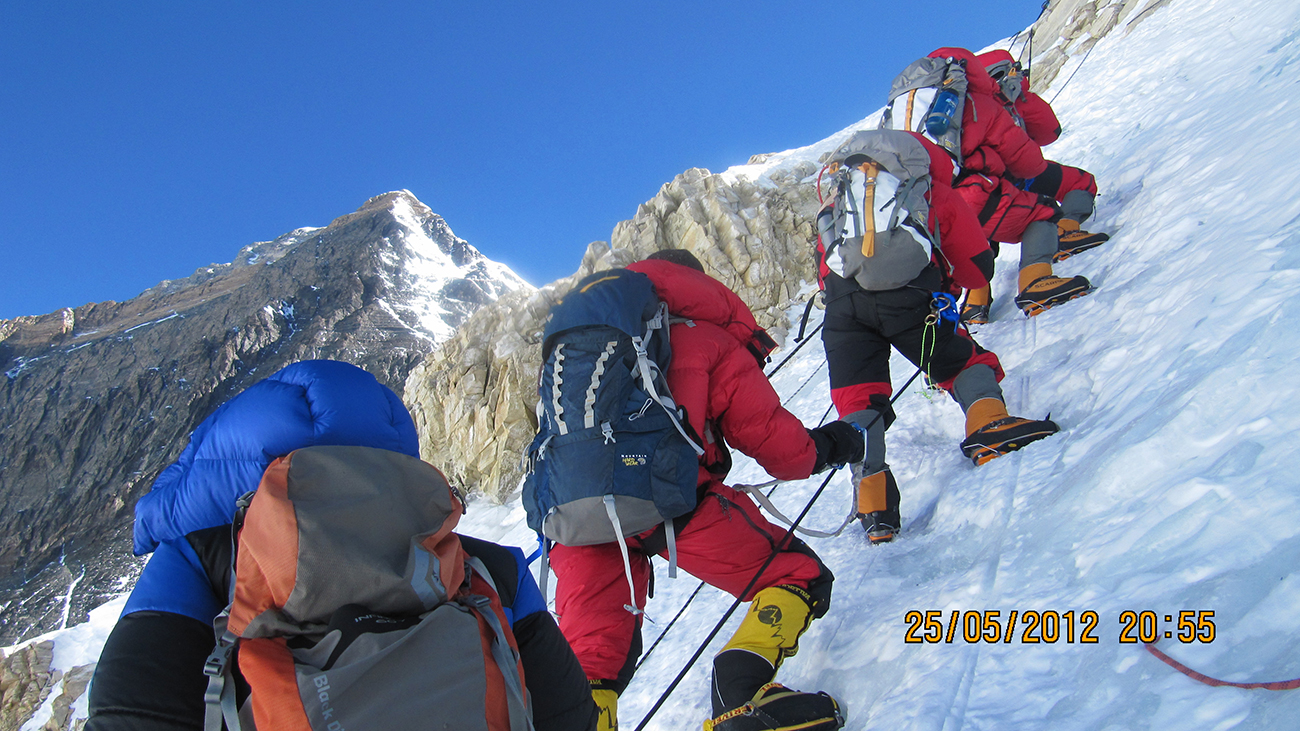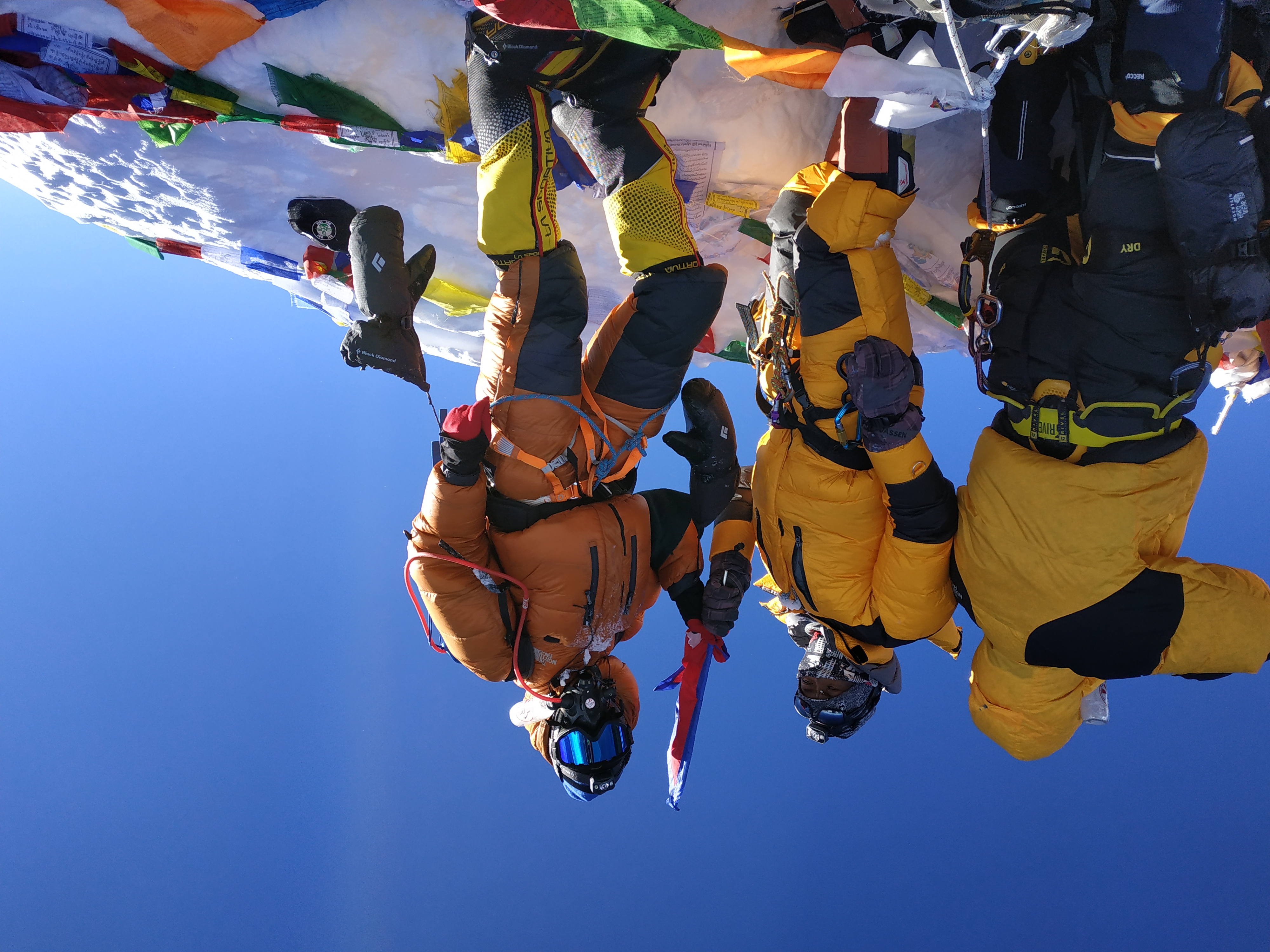Everest Region with no doubt is the most admired destination in Nepal as it is the region of crowning Mt. Everest (8,848m/29,029ft). It was on 29th May 1953 when the summit of the tallest mountain of the world, Mt. Everest was first conquered by two legends Tenzing Norgay Sherpa from Nepal and Sir Edmund Hillary from New Zealand from the Southern slope. Since then, hundreds of climbers have successfully conquered the summit of Mt. Everest. Â The Mt. Everest has around 1000 summit attempts every year and has become a benchmark of climbing achievements. The climbing to the summit of Everest is an incredible experience. This lifetime experience climbing formally starts exactly from the Everest base camp which is positioned at the height of 5300m. Mt. Everest expedition is technically difficult. It needs good physical and mental effort to attempts this type of climbing. Therefore, climbing peaks below 8000m like Island peak, Pisang peak, etc before attempting this expedition is highly suggested. The climb takes us along the normal route via the South Col, crossing the base camp and additional four camps in Mt. Everest at approximately 5800, 6200m, 7200m and 8000m respectively. Afterwards, we cross the last section known as Hillary step to reach the summit. The Hillary Step is the most difficult section throughout the climbing period. The Southside route is technically straightforward and easy than the north side. It is also the most frequently-used and busy route than the northeast ridge from China. But we should be aware of the potential sudden weather changes and the risks involved. The weather in Everest is unpredictable. Therefore a good preparation before climbing is highly suggested. Everest region consists of two main climbing routes, the southeast ridge from Nepal and the northeast ridge from China. The northeast ridge is technically difficult and less frequently climbed the route. The southeast ridge is the route used by Hillary and Tenzing in 1953. Moreover, it is the first recognized route of fifteen routes to the top by 1996.
Brief Itinerary: (The following is the example)
Day 01: Arrival at Kathmandu and transfer to hotel
Day 02: Kathmandu sightseeing program
Day 03: Preparation day for expedition
Day 04: Fly to Lukla (2886m), & trek to Phakding (2640m.), 3 hr O/N lodge/camp
Day 05: Trek to Namche Bazaar (3440 m.), 5 hrs..
Day 06: Rest at Namche Bazaar for acclimatization and excursion
Day 07: Trek to Tyangboche (3867 m.) 5hrs. O/N lodge/camp
Day 08: Trek to Dingboche (4260m.) 5hrs. O/N lodge/camp
Day 09: Rest at Dingboche for acclimatization and excursion
Day 10: Trek to Lobuche (4930 m.), 6 hrs. O/N lodge/camp
Day 11: Trek to Kala Patthar via Gorakshep O/N lodge/camp
Day 12: Trek to & from Everst Base camp (5545 m).O/N lodge/camp
Day 13-53: Mount Everest Climbing period
Day 54: Trek to Pheriche(4240 m). O/N lodge/camp
Day 55: Trek to Tyangboche (3860 m.), 4 hrs. O/N lodge/camp
Day 56: Trek to Monjo. O/N lodge/camp
Day 57: Trek to Lukla. O/N lodge/camp
Day 58: Fly back from Lukla to Kathmandu & transfer to hotel
Day 59: Rest day in Kathmandu. Stay overnight at hotel in Kathmandu
Day 60: Final departure
Day 01: Arrive in Kathmandu via respective airlines then- Check-In to your Hotel.
On arrival, our staff will receive and transfer you to the respective Hotels.
Day 02-04: Preparation of the expeditions:
These days will be used obtaining necessary paper works and documents with the Sherpa staff, making of the climbing permits, Visa and a visit to the Ministry of Tourism for Official briefings.
Day 05: Fly from Kathmandu to Lukla and trek to Phakding 2,650m 3-4 hrs.
Transfer to the domestic airport for one of the great flights of the Himalaya.
If the sky is clear during the flight, one can get the first views of the Mt.Everest.
The Twin-Otter / Dornier or similar aircraft will take to the hillside village of Lukla,
the starting point of the trek. Here meet the staff and the porters and set off straight away for Phakding, situated on the banks of the Dudh Kosi River, which drains the whole of the Khumbu.
Day 06: Trek to Namche Bazaar 3,440m 5-6 hrs.
The walk continues up the banks of the Dudh Kosi River, crossing it twice by small suspension bridges, before reaching the village of Monjo, which is the entrance to the Khumbu National Park. Then cross the confluence of the Dudh Kosi and Bhote Kosi rivers on a high suspension bridge and climb steeply for about two hours to Namche Bazaar. This is a prosperous trading town and is the capital of the Khumbu region. Many Tibetans cross the nearby border to trade their wares and the local market is a fascinating spectacle. This is a good place to buy genuine Tibetan artifacts. Just across the valley to the east stand the peaks of Thamserku and Kangtega, both very impressive mountains.
Day 07: A day in Namche Bazaar.
Rest and at leisure allowing the bodies to become more acclimatized to the altitude of 11,300ft /3,440m.
Day 08: Trek to Thame 3,880m 04 hours.
A moderate short trek leafs slowly to Thame, encountering many monasteries on route, morning walk through the forest and follow Bhote Koshi River to reach the village of Thame, then following the river to reach a small suspension bridge, with awesome Buddhist Rock Wall Paintings on the wall at the hill, crossing the bridge, trek for less than half-hour to reach the small settlement of Thame.
Thame is famous for being the birthplace of Tenzing Norgay (one of the first person to climb over Mt. Everest) and of Apa Sherpa a record holder climbing 20th time on top of Mt. Everest.
Day 09: Trek to Marlung 4,137 m 04 hours.
Leaving Thame, head to Marlung following the Bhote Koshi River, passing the villages like Thyangmoche and Hungmo, and then trekking through only a few houses and less vegetation on the way towards the alpine zone. The trail crosses the village of Taranga, through the yak field to reach Marlung village for the overnight stop.
Day 10: Trek to Lungdeng 4,600 m 03 hours.
Morning walk leads to Lungden passing through very old, authentic Himalayan Villages that blends into the surrounding landscape; on the trail of the old salt trade route between Nepal and Tibet, and then walking for few more hours to reach the small village of Lungdeng for an overnight stop in Lungden.
Day 11: Trek to Renjo- La 5,465 m / 17,929 ft and to Gokyo 4,800 m 07 hrs.
Leaving Lungden, following the trail leading to the frozen ponds below Renjo La pass, offering fantastic views of Mt.Everest, Lhotse, Cholatse, and Taboche, and then cross Renjo La pass, the most difficult section of this trekking to reach the valley of Gokyo for an overnight stop.
Day 12: Rest day at Gokyo Lake.
A rest day which allows you to acclimatize better in this high altitude, with time to explore the surrounding area of this valley with stunning scenery of the first and the second lake of Gokyo.
Day 13: Hike to Gokyo Ri at 5,330 m /17,483 ft and trek to Thangnag
4,750 m / 15,580 f o5 hrs.
Today early morning hike to Gokyo Ri for mind-blowing views of Mt.Everest,
Mt. Lhotse, Mt. Makalu, Mt. Cho-Oyu the world’s 01st, 04th, 05th and 06th highest mountain in one lot with other smaller peaks around including the beautiful Gokyo Lake and Khumbu’s longest Ngzumba glacier which starts from the base of Mt.Cho Oyu that straddles the border with Tibet, after a grand moment walk back to Gokyo and continue trek to Thangnag walking along the glacier moraines, follow the trail and reach the small settlement of Thangnag for overnight stop.
Day 14: Cross Cho-la 5,367m / 17,604 f and to Dzongla 4,850 m 06 hrs.
After an early breakfast follows the trail that leads steeply to ascend and then crossing the glacier on the eastern side. The pass stands at an elevation of 5,367m and is quite challenging to cross (in snow conditions), with views of impressive high mountains and of Cholatse Glacier and its small lake on the way to Dzongla for the overnight stop.
Day 15: Climb to Lobuche High Camp 5,600m / 18,368 ft. 04 hrs.
On this day first, pack climbing gear and make a gentle climb to reach the high camp. The climb takes almost four to five hours to reach the high camp, climb through rocky moraine path to reach High Camp with the final preparation for the climbing and overnight in tented camp.
Day 16: Climb to the summit 6,119m / 20,070 ft and to Base Camp, 8-10 hrs.
The climb to the summit is steep climbing which is slightly difficult. So our guide and leader will fix rope where it is necessary for this strenuous ascent to reach the summit, from the top breathtaking views of the staggeri8ng high mountains that surround you. After spending some time on the summit descend along the same route to base camp.
Day 17: Reserve day in case of unfavorable weather condition
The weather condition around high Himalaya is unpredictable; have to wait sometimes for the good favorable weather condition. So, reserve this extra day in case of bad weather conditions.
Day 18: Lobuche rest day.
Day 19: Trek to Gorak Shep 5,180m 2-3 hrs.
Continue along the side of the Khumbu Glacier which is straight forward at first, but later the path becomes rocky and awkward climb across the moraine. This is more than compensated by the fabulous mountain setting as the path gets closer to the world’s highest mountain. The sugarloaf dome of Pumori lies directly ahead and to our right, on the opposite side of the glacier, Nuptse rises in a sheer spire. Just behind it, remains elusive to the last moment is the Mt. Everest. Gorak Shep is another small cluster of tea shops and will be camping just below them. Directly above the campsite is Kala Pattar [18,188ft/5,545m.]. This is a famous view-point for Mount Everest and the 1½ hour scramble to reach; it is well worth the effort.
Day 20: Trek to Base Camp 5,360m. 3-4 hrs.
Climbing over the mounds of moraine traverse the Khumbu Glacier and follow a vague path to the most famous of all Base Camps. It lies right at the foot of the notorious Khumbu Ice Fall which tumbles from the Western Cwm. The Base Camp will be already well established and you can find out how the Advance Party is progressing in the Ice-fall.
Day 21-48: (27 days) Ascent of Mount Everest and withdrawal to Base Camp.
It is hoped that the Khumbu Ice-fall will be fixed by the time the team arrives at the Base Camp. Members can then start load-carrying to Camp I and Camp II, in the Western Cwm. Once everyone is well acclimatized, Camp I will be mostly by-passed en-route for Camp II, which will become an Advance Base Camp. The route to this point will involve crossing the crevasses on ladders, jumaring up serac walls and a long tedious plod-up the Western Cwm. Camp III will be placed halfway up the Lhotse Face at about 7,400 meters high. From here a long rising traverse across the snow slopes, a yellow band of rock and the Geneva Spur, leads to the South Col and Camp IV. This will be fully established before a rest period at Base Camp.
Day 49, 50, 51: All team members are to re-group at the Base Camp
To assist with packing-up the expedition and clearing the Base Camp areas.
Day 52: End of the Expedition.
The final end of the great expeditions to the world’s number mountain, preparation for the
Journey back to Kathmandu and with garbage clean up.
Day 53: Return trek to Pheriche 5-6 hrs.
Retrace the journey back to Pheriche by the same route.
Day 54: Trek back to Thyangboche.
Retrace the trekking journey by the same route passing through Pangboche.
Day 55: Trek to Namche Bazaar.
Retrace the trekking journey by the same route to Namche with an optional route by Khumjung and Khunde from the village of Shanasa.
Day 56: Trek to Lukla. 6-7 hrs.
Today’s walk leads to almost downhill with short ups on route to Lukla.
Day 57: Fly from Lukla to Kathmandu.
Most of the flight takes off in the morning time, a great scenic sweeping flight of 30 minutes reaches you at Kathmandu, and transfer to respective Hotels.
Day 58: At leisure in Kathmandu.
Time for some last-minute shopping or sightseeing, or one can just relax in the Hotel.
In the evening with a get together farewell party at the Hotel itself, including the Sherpas and other friends Recovering from the past exhausting days and nights- re-generating!
Day 59: Depart from Kathmandu – Journey homeward bound!
Today keep your passport and airline ticket handy our office staff will transfer you to the International airport for your flight back home or to the respective destination from this amazing country Nepal.
Camp1:20013ft.(6,100m)
This camp 1 is situated at the head of Khumb ice fall where has a flat area of endless snow deep crevasses and mountain walls. Because of the Sun’s reflection from this place we get warm and heating ambiance at this place. In the night we listen to the deep murmuring cracking sounds of crevasses beneath our tent. These are the areas where we have to walk to reach camp 2 between Base camp. Camp 1 we have to cross a few ladders it proper setup by icefall doctor it strong and safe to walk. From camp 1 we can see in South-West face like Pumari, Kalapatthar, Cho-Oyu and from East- North face we can see like Lhotse.
Camp2.20997.375ft.(6,400m)
This camp 2 is situated at the height of the 21000ft, which is located at the foot of the icy mount Lhotse wall though where we have to go ahead. Weather is here is good but bad clouds roll in from the low range of the Himalayan valleys to the bottom of our camp two. But wind here sometimes seems very violent enough to destroy our tents. After climbing these palaces we reach camp 3.
Camp3.23293ft.(7,100m)
Camp 3 is located at the height of 22300ft, adjoining to mount the Lhotse wall. After climbing the 4000ft. Lhotse wall by using fixed rope and with prior acclimatization it leads us to camp 4. Also on the way we have to ascend the steep allow bands (lose, down -slopping and rotten limestone). From their crossing short snowfield, the route moves ahead up the Geneva Spur to the east before finishing the flats of the south col. Oxygen should probably be use above base camp 3 in case of needed to the climbers.
Camp4.26256ft.(8,000m)
Now we are on camp 4 south col which located at the height of 26256ft;/8000m. It is the last camp of the Expedition. From here the summit is about 848m, a distance far. This is the final and dangerous part of the climbing. This place is besieged by ferocious and violent winds. The normal best way to reach the summit is via the narrow South – East Ridge and it precedes the South Summits 28710ft.
From here the way is easy to reach the summit of the Everest 29028ft;/8848m. And late Sir Edmond Hillary and l Tenzing Norgay Sherpa used this route in 1953.
Note: We start the walk and climb from the camp 3 to 4 am mooning after having breakfast from camp 4 south col to the summit we start around 6 to 7 pm.
Cost Include:
- 5 nights 3-star standard hotels in Kathmandu with bed & breakfast
- Everest peak permit Fee
- Sagarmatha National Park Fee
- SPCC Fee
- Liaison officer insurance, wedge, and equipment allowance.
- Helicopter Rescue insurance for Nepali staffs
- Each member 8 oxygen bottle and 1 regulator mask and set (2 regulators and mask will be carried extra for safety purpose)
- Each climbing Sherpa and climbing leader 5 bottle oxygen and regulator and mask set
- Generator or Solar panel at Base Camp for light and devices charging
- Sleeping Tent (There will be an individual tent at base camp. Above Base camp, two persons will share a single tent.)
- Lodging and catering service (from Lukla to Base camp we will do lodge trek. These lodges provide both satisfactory lodging and foods. At base camp and Camp2, our well-experienced kitchen staff prepares excellent foods. For camp1 and camp3 high altitude food and energy drinks and bars will be provided. The foods provided by our company will be very hygienic, highly nutritious and of great varieties.)
- 1 High Altitude Sherpa for each climbing member.
- 1 IFMGA certified mountain guide in the group as a leader of the whole expedition.
- Base camp services (heated dining tent, Tables, Chairs, Toilet tent, Kitchen tent and shower tent, store tent, kitchen crew)
- Gamow bag (at base camp only),
- Oxygen and regulator Mask at each camp for medical purposes
- Camp 2 services (dining tent, Kitchen tent toilet tent, 1 cook and 2 helpers)
- Mountain guide and climbing Sherpa, Daily wages, equipment allowance, and load ferry and summit bonus
- Base camp cook, helper, and camp2 cook and helper daily wages and equipment allowance.
- Porters or Yak charges for carrying gears, food, fuel, and equipment from Lukla to Base camp and back.
- Transportation: Kathmandu to Lukla and return flight tickets for the members & flight cargo for the food and equipment.
- Garbage Deposit.
- Communication (1 walkie talkie for each member and climbing guide and Sherpa, 2 radio base station at base camp and camp2, internet at base camp
Cost Excludes:
- International flight to and from Kathmandu
- Lunch and dinner in Kathmandu
- Laundry, postage, telephone calls and all other items of personal nature.
- Entry visa and Re-entry for Nepal.
- International departure tax.
- Personal Expenses.
- Medical and rescue insurance.
- Personal Climbing equipment
- Bar Bills and beverage
- Medicine and first aid expenses
- Emergency rescue evacuation if required
- Satellite phone in payable basis (per minute $ 5) and
- local mobile phone service









